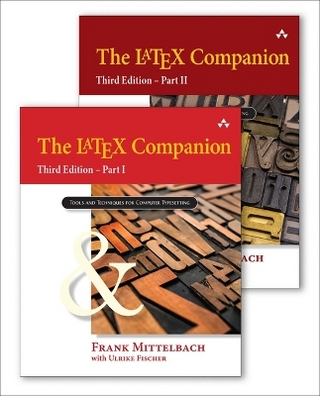
The Handbook of Digital Publishing, Volume II
Prentice Hall (Verlag)
978-0-13-029371-8 (ISBN)
- Titel ist leider vergriffen;
keine Neuauflage - Artikel merken
*The definitive, up-to-the-minute guide to digital publishing *Color management, digital workflow, multimedia, Web publishing, and more *Practical and easy to understand, with hundreds of illustrations *Includes 16-page color section *By one of the world's foremost authorities on digital publishing Second in a 2-volume set The definitive digital publishing resource, by the world's foremost authority! Volume II: Color management, digital workflow, multimedia/new media, and Web publishing 16-page color section demonstrates key color concepts and techniques The digital publishing industry finally has a single, up-to-date source for authoritative information on every aspect of digital publishing: techniques, technologies, media, workflow, and beyond! In this, the second of a two-volume set, the world's leading authority on digital publishing offers powerful insight into everything from color models to Web advertising, DVD development to e-books.
Crystal-clear and packed with illustrations, Michael Kleper's The Handbook of Digital Publishing, Volume II covers all this, and more: *Color management: concepts, systems, and applications-print and online *Digital workflow, data flow, job engineering, asset management, connectivity, and networking *Multimedia/new media: audio, video, 3D modeling, animation, VRML, CD-ROM, DVD, and more *Web publishing: planning, components, site development, promotion, and more *Careers in Web publishing, design, and electronic media From intellectual property protection to on-demand publishing, The Handbook of Digital Publishing, Volume II covers today's most critical digital publishing issues with unprecedented breadth and depth. Whatever your role in publishing, whatever media and tools you use, it's the most valuable reference and "how-to" tutorial you can own.
MICHAEL KLEPER is full professor and member of the Senior Faculty in the Digital Imaging and Publishing Technology Department at the Rochester Institute of Technology. He has 30 years of college teaching and research experience in print, desktop, and electronic publishing, electronic prepress, typography, and page creation. His seven books include The Illustrated Handbook of Desktop Publishing and Typesetting, Second Edition. He edits The Kleper Report on Digital Publishing (www.printerport.com/kdp) which originated in print form in 1979.
I. COLOR MANAGEMENT CONCEPTS, SYSTEMS, AND APPLICATIONS.
1. Color Theory and Color Models.
Color Perception. Subjective Color. Why Color? Color Models. Color Space. Variations of RGB. Color Palette.
2. Color Viewing and Reproduction.
Color and Tone. Spot Color. Scanner Color. Color Monitor Adjustment. Transfer Function. Monitor Calibration. Monitor Color Management. Color Correction. Color at the Pixel Level. High-Fidelity Printing. Digital Color Reproduction. Pleasing Color. Color Control. Color Separation. Screening Technology. Standardized Printing Specifications.
3. Color Management Systems (CMS).
ColorSync. ICC Color Profiles. Embedded ICC Profiles. From Displayed Color to Printed Color. Alternatives to Full-Color Reproduction. PDF and Color.
4. Color Reference Systems.
Color Communication. Color Reference Systems. The Color Wheel. PANTONE. TOYO and DIC. Trumatch. Focoltone Colour System. Color Viewing. Color Preference. Color Meaning. Color Forecasting. Color and Organization.
5. Nonprint Color Markets.
Color Concerns on the World Wide Web. ICC Profiles. sRGB. True Internet Color. The Design Phase. The Distribution Phase. Office Color. Video Color. Color in Motion Pictures. Publication Permanence.
II. DIGITAL WORKFLOW AND JOB ENGINEERING.
6. Digital Workflow.
The All-Digital Workflow. Digital Workflow by Technology Segment. Graphic Arts Digital Workflows. Web Publishing Digital Workflows. The Pathway to Efficiency. Workflow versus Jobflow. Core Computer Competencies. File Management. Computer Networks. The Local Area Network (LAN). Wide Area Network (WAN). Network Administrator. Networking Basics. Network Topology (Layout). Network Security. Computer Platforms. Computer Skills. Removable Media. The Benefits of High-Capacity Removable Media. Media Archiving. File, Program, and System Security. File Compression. Data Encryption. Nimble Media Forms.
7. Digital Asset Management (DAM).
Cross-Media Publishing versus Repurposing. Digital Asset Management Basics. File Naming Conventions. Image File Content Attributes. Image Analysis. Data Life. Data Security. The DAM Market. Content Management. File Formats. File Format Basics. Sources of Digital Images. Flat-Copy Conversion. Film Conversion. 3-D Objects. Image Collections. Commercial Images. Standard Bitmap File Formats. GIF. JPEG. PNG. FAST Image Transfer. MrSID Publishing Edition” Version 1.0. PhotoJazz. Flashpix. Technical Aspects of Bitmap Files. Resolution. Bit Depth (Color Depth). Scaling. Compression. Standard Vector File Formats. Flash. SVG. Bitmap File versus Vector File. SpriteLayers. Cross-Category File Format Conversion. Raster-to-Vector Conversions. Data Encoding. Managing Large Files. Digital Asset Protection. FirstUse. Digital Watermarking.
8. Digital Job Engineering.
Where Does the Digital Path Begin? Digital Path Scenarios. Scenario One: The Self-Publisher—One Person/One Computer. Scenario Two: The Small Office/Home Office (SOHO) User. Scenario Three: The Small-to-Medium-Size Publisher. Scenario Four: The Corporate Environment. Scenario Five: The Advertising Agency. Scenario Six: The Newspaper. Digital Job Submission. The Job Intake Procedure. Job Engineering. Flightcheck. Why Does WYSIWYG Fail? Who's Responsible for Preflight? What Should Be Checked during Preflight? When Should Preflight Occur? Steps to Avoid Potential Output Problems. The PostScript File versus the Native File Format Decision. Preflight Automation. Job Submission. Standard Job Submission Formats. Application Format. PostScript Format. Adobe Acrobat PDF Format. TIFF-IT. Media-Neutral Digital Assets. Digital Stripping. Trapping. Imposition. Ganging Jobs. Bleeds. Inside and Outside Forms. Finishing. Paper. The Physical Properties of Paper. Simple Paper Tests. Paper Classification. Paper Finishing Operations. Ink. Work Marks. Job Proofing. Proofing Black-and-White in Black-and-White. Proofing Spot Color in Black-and-White. Proofing Spot and Process Color in Color. Requirements for Desktop Color Proofers. Low-cost In-shop, In-studio, and In-home Proofing. Remote Proofing. The Film Legacy. Computer-to-Plate. Color Issues Related to Workflow. Workflow Management. A Commercial Digital Workflow. Organizations Committed to the Propagation of the All-digital Workflow. Digital Distribution of Advertising for Publication Association. The Digital Ad Lab. OPI. DCS. The Final Hurdle for Print: From Page Language Format to Raster Data. Soft RIP. The Role of the RIPping Process in Digital Workflow. Various PostScript Workflows. Special RIP Requirements. Total Print Production. Semiautomated Workflow.
9. Connectivity and Digital Data Flow.
Using a Network. Physical Cabling Systems. Twisted Pair. Coaxial Cable. Fiber Optic. The Network. Ethernet. Networking for the SOHO Market. Networking Options. Modem Communication. ADSL. HSDL. Cable Modems. ISDN. The Internet. Fixed-Link Services. Commercial Service Providers. Data Movement to and from the Computer. Serial (EIA232). Parallel (Centronics Parallel). SCSI (Small Computer Systems Interface). FireWire (IEEE 1394 Serial Bus Standard). IDE (Integrated Drive Electronics). ATAPI (AT Attachment Packet Interface). SDI (Serial Digital Interface). USB (Universal Serial Bus). WideBand. Fibre Channel. IrDA DATA. AirPort. Additional Computer Data Ports. Bluetooth”.
III. MULTIMEDIA TECHNOLOGIES.
10. The Process and Applications.
Cross-Media. New Media. Interactive Multimedia. The Delivery System. Multimedia Production: People and Skills. The Producer (also Program Manager, Project Manager, Multimedia Producer/Designer). Content Expert(s) (also Subject Matter Expert, Editor). Instructional Designer (also Multimedia Designer, Information Designer). Scriptwriter (also Writer/Designer, Multimedia Writer). Multimedia-Authoring Specialist. Computer Graphic Artist (also Graphic Designer, Interface Designer, Image Processing Specialist). Audio Specialist. Video Specialist. Multimedia Programmer (also Software Engineer). Conventional Uses for Multimedia. Multimedia Authoring: Macromedia Director 8. Sprites. Starting a Director Project. Assembling and Directing the Cast. Refinements to the Score. Sprite Animation. Additional Production Refinements. Publishing a Director Project.
11. Digital Audio.
Sound Basics. Digital Sound. Sound Sources. Multimedia Music Clips. TuneBuilder. Found Sounds. Audio Production. Sound Mixing. Multimedia Music and Sound Effects Libraries. MIDI. MOD. MP3. Music Publishing. Rights and Clearances. Digital Sound on Disc. Licensing. The Marketplace. File Size. Locating the Right Music.
12. Digital Video.
What Is Digital Video? Platform Considerations. Digital Video Isn't Television. Standard Video Formats. Digital Video Standards. The Recording Process. Compression. Desktop Movie Production. The Movie-Making Process. Digital Video Clips on CD-ROM.
13. Three-Dimensional Modeling.
The Elements of 3-D. Modeling. Positioning and Sizing. Adding a Surface. Building Complex Objects. Adding Text. Adding a Terrain. Adding Lighting. Deforming an Object. Adding Particles. Moving the Camera. Rendering. 3-D Model Libraries.
14. Animation.
Why Use Animation? The Production Process. Types of Computer Animation. QuickTime Animation.
15. Virtual Reality Modeling Language (VRML) and Immersive Technology.
History. The Purpose of VRML. How It Works. The Essence of VRML. Real-Time 3-D on the Web. Web Performance. QuickTime VR (QTVR). QuickTime VR Panorama Mode. QuickTime VR Object Mode. QuickTime VR Scene Mode. MetaStream 3.0 (MTS 3).
16. CD-ROM and DVD.
Using CD-ROM Discs. Standard Formats. CD-R Media. Unstructured Data. CD-RW. DVD Technology. DVD-ROM. DVD-Video. DIVX (Digital Video Express). DVD-Audio. DVD-R. DVD-RAM. DVD+RW. DVD Acceptance. Disk Formatting. Hybrid Technologies. WebCD and WebDVD. Print Hybrids. Platform Hybrids. Digital Dispensary. Authoring and Disc Production. Data Preparation. Premastering. Replication. Assembly and Packaging.
IV. WEB PUBLISHING AND NEW MEDIA.
17. The Internet.
TCP/IP. Internet IP Addresses. TCP/IP Ports. Domain Names. Domain Name Server (DNS). Uniform Resource Locators (URLs). FTP. Gopher. Telnet. Clients and Hosts. Access. The Internet Service Provider (ISP). What to Look for in an ISP. Site Requirements. Who Provides Internet Services? Finding an ISP. Web Servers. Server Services. Client Support. Performance. File Types. Personal Web Serving. Security. Multimedia Types. Java Applets and JavaScript. JavaScript. Web Broadcasting. Security. What Are the Threats? What Are the Protections? What Can You Do?
18. The World Wide Web.
The Web Client. The HyperText Publishing Language. The Internet Protocol. The Web Server. Web Size and Growth. Why Publish on the Web? De-skilling the Web. Basic Web Page Construction. The Minimum HTML Structure. Typographic Coding. Establishing Links. Anchors. Mailto. Graphics. The Use of Color. The Background. Tables. Code Validation. Cross Platform/Cross Browser Compatibility. Accessibility.
19. Web Site Components and Construction.
The FAQ. Site Navigation. Image Maps. Building Hits. Constructing Pages That Can Be Easily Found. Tag Creation. The Dublin Core Metadata Initiative. Submission Services. Metasearch Engines. Search Criteria. Search by Relevance. On-Site Searches. Site Recognition, Distinction, and Rating. Monitoring Links to a Site. Counters. Tuning and Testing Web Pages. Web Browsing Off-line. Browser-Supported Captures. Screen Captures. Page and Site Captures.
20. Web Site Advertising and Promotion.
Information Delivery via E-mail. E-mail Address Conventions. Conventional E-mail Message Construction. Attachments. The E-Mail Publisher. Multimedia E-mail. E-mail Mailing Lists. Personalized E-Mail. Web Site Advertising Standards. Types of Web Advertising. Rich Media Authoring. Standard Banner Sizes. Banner Ad Placement. Banner Ad Guidelines. Generating Traffic. Benefits of Web Advertising. Measuring Effectiveness. Ad Placements. Data Gathering. Web Forms. PDF Forms. On-line Form Construction. Data Sharing. Database Publishing on the Web.
21. Web Publishers and Their Audiences.
Web User Behavior. Reader Feedback. Behaviors of the Responsible Reader. Behaviors of the Responsible Publisher.
22. Careers in Web Publishing.
World Wide Web Job Areas, Titles, and Responsibilities. Major Areas. Job Prerequisites. Specific Job Titles. References. The Web Professional within the Organization. Independent Web Consultant. Temporary Web Development Team. Professional Web Development Team. Large Web Operation. Medium-sized Web Operation. Limited Corporate or Independent Web Operations.
23. Electronic Books and the Protection of Digitally Encoded Intellectual Property.
History. Early Forms of Commercial e-Books. Why e-Books Make Sense to Publishers. Why e-Books Make Sense to Distributors and Retailers. Why e-Books Make Sense to Authors. Why e-Books Make Sense to Readers. Distinctive Capabilities. Time-Limited Access. Portability. Digital Advantages. e-Book Authoring. Open eBook (OEB) Specification. Adobe Acrobat PDF. TK3. Softbook Personal Publisher. e-Book Readers. The EB Dedicated Reader. RocketBook. Microsoft Reader. PDAs. Glassbook. PC-based e-Book Readers. High-Fidelity Digital Books. Field-Scanned e-Books. HP CapShare 920. QuickLink. The Free On-line Digital Book Library. Digital Document Content Protection. PageVault. ContentGuard. Dynamic On-line Publishing. e-Book Publishing Systems. InfiniteInk. OverDrive Systems. Peanut Press. Author to Reader. Web Library and Bookstore. Traditional Bookstores. Electronic Ink and Electronic Paper. E-Paper. E Ink. The Protection of Intellectual Property. The U.S. Copyright Act of 1976. Copyright Office Electronic Registration, Recordation and Deposit System (CORDS). The Digital Millennium Copyright Act (DMCA) of 1998.
24. On-Demand Publishing Technology.
Printing On-Demand (POD). Forms of Print On-Demand Input. Author and Publisher Roles in Print On-Demand Publishing. Print on-Demand Newspapers. Printing. Page Printers. Xerographic Copiers. Production Copier-Printers. Digital Presses. Offset Presses. Direct-Imaging Presses. Delivery Systems. Variable-Data Printing. Variable-Data Files. Finishing Systems. Printing as part of e-Commerce. Print-based E-Businesses.
Appendix A: Vendor Listing.
Appendix B: Trade Associations, Professional Organizations, and Industry Groups.
Bibliography.
Index.
| Erscheint lt. Verlag | 25.1.2001 |
|---|---|
| Verlagsort | Upper Saddle River |
| Sprache | englisch |
| Maße | 217 x 284 mm |
| Gewicht | 2111 g |
| Themenwelt | Informatik ► Grafik / Design ► Desktop Publishing / Typographie |
| Mathematik / Informatik ► Informatik ► Web / Internet | |
| Sozialwissenschaften ► Kommunikation / Medien ► Buchhandel / Bibliothekswesen | |
| ISBN-10 | 0-13-029371-7 / 0130293717 |
| ISBN-13 | 978-0-13-029371-8 / 9780130293718 |
| Zustand | Neuware |
| Haben Sie eine Frage zum Produkt? |
aus dem Bereich


